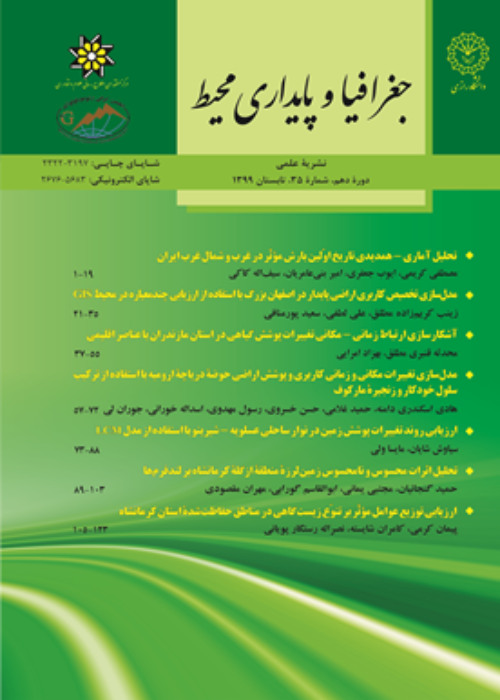Investigating the resilience of Dehgolan County against natural disasters
Nowadays, natural disasters threaten human societies. In the case of lack of awareness and readiness, irreparable damage threatens to human life, including residential areas and other dimensions, economic, social, institutional, and physical-environmental. As a result, communities have different approaches to reduce the impact of natural disasters. One of these approaches is resilience against natural disasters. This research studies the effective economic, social, institutional, and physical-environmental factors on the resilience of Dehgolan's county against natural disasters. Dehgolan county is located in the east of Kurdistan province. The present research is based on applied research and the method is descriptive-analytical and surveying. To collect field information using the household questionnaire technique and to do the analysis of the T-test one-sample test, regression, and ANOVA were used. Cronbach's alpha coefficient was used to determine the reliability of the questionnaire, and its value was 0.88 for the entire questionnaire. The results of the t-test showed that the level of resilience of Dehgolan county against natural disasters in the physical-environmental, economic, social and institutional dimensions is optimal with an average of 3.476, 3.358, 3.315, and 3.306 respectively. But considering the significant level of the physical-environmental dimension (0.056) which is greater than (p>0.05), it cannot have an impact on the resilience of Dehgolan county. In this way, the economic dimension has the most impact on the resilience of this county, and the social and institutional dimensions are in the next ranks. The results of this research can be used by Officials and planners to deal with natural disasters.
Nowadays, natural disasters and hazards are increasingly threatening human societies. Therefore, human beings, as managerial rulers anywhere in the world, need to take managerial measures to reduce risks to make communities resilient to natural disasters. One of the problems that have always threatened the lives of human societies for many centuries is the occurrence of disasters and hazards that, if unaware and unprepared, cause irreparable damage to various aspects of human life, including residential areas and their housing, social, economic, environmental, psychological, and so on. Natural disasters are hazards that occur unexpectedly and sometimes inevitably and are beyond the capacity of societies' adaptation due to the expansion of material and human resources and the interruption of the natural course of life. There are two strategies to face disasters and hazards: prediction strategies and resilience strategies. The former is used to deal with known problems and issues, and the latter is used to deal with unknown problems. Since one of the most important factors that mitigate the damage of natural disasters in communities is the prior preparedness to deal with such disasters, it can be done through optimal and principled planning to a large extent. Communities' resilience to the effects of natural disasters involves a complex set of interdependencies of economic, social, and environmental characteristics. Major economic and social conditions, etc. in the community before sudden disruptions warn the ability of residents against natural disasters so that local decision-makers provide the necessary resources within the local or intra-government and foster managers and people to coordinate a quick and effective response. Iran is one of the most vulnerable countries in the world due to its climatic and geological characteristics and especially its location on the Alpine-Himalayan seismic belt. It has a high vulnerability to natural disasters so 31.7 percent of its total area is located in areas prone to natural disasters, and 70 percent of the population lives in different areas exposed to natural disasters. The current study aimed to investigate the resilience of different areas of Dehgolan county in four aspects economic, social, institutional, and physical-environmental to mitigate the effect of natural disasters.
The current study investigated the influential economic, social, institutional, and environmental factors in the resilience of different areas of Dehgolan county against natural hazards. This study was applied, and analytical-descriptive and survey research. Field research and researcher-made questionnaires were used to collect the data and study the resilience of studies and villages of Dehgolan county. Data obtained from the questionnaire were analyzed using a One-sample t-test, regression analysis, and One-way Analysis of Variance (ANOVA). The statistical population in the current study included the heads of households of two cities (Dehgolan and Bolbanabad cities) and ten villages of Dehgolan county selected by a simple random sampling method. The statistical sample size of the research was 376 households based on Cochran's formula. Opinions of professors of Tabriz University and experts of some organizations and administrations of the county were used for the validity of the questionnaire, and the selected indicators and the questionnaire and components were investigated based on the research subject. Cronbach’s alpha coefficient was used to determine the reliability of the questionnaire the value of which was 0.88, indicating high reliability.
In the current study, a one-sample t-test was used to evaluate the different areas of Dehgolan county in terms of economic, social, institutional, and physical-environmental indicators. The results obtained showed that the environmental-physical indicator with a mean value of 3.476, the economic indicator with a mean value of 3.358, the social indicator with a mean value of 3.315, and the institutional indicator with a mean value of 3.06, have the ability to influence the resilience of Dehgolan county against natural disasters. The findings indicated that there is a difference in the county in terms of environmental-physical, institutional, social, and economic indicators. Linear regression and correlation coefficient were used to investigate the effect of each of these aspects on the resilience of Dehgolan county. The results depicted that the correlation coefficient was 0.37 among the indicators. Overall, according to the obtained results, the resilience (in four aspects of economic, social, institutional, and environmental-physical) was higher than 3, indicating a suitable condition of resilience in Dehgolan county. But considering the significant level of the physical-environmental dimension (0.056) which is greater than (p>0.05), it cannot have an impact on the resilience of Dehgolan county.
The current study investigated the resilience of Dehgolan county based on four aspects economic, social, institutional, and environmental-physical. The high average of the dimensions of resilience shows that, based on the opinion of the residents of the local community, the resilience of the areas of Dehgolan county is in a suitable condition. That is, it can be said that the people of Dehgolan county have the necessary resilience to return to their original state in the face of various natural disasters. This situation is consistent with the findings of Masoompour Samakusho et al. (2020) and Pudine et al. (2021). However, this is contrary to the results of Behtash's studies (2012) regarding the low resilience of Tabriz city against natural disasters.
- حق عضویت دریافتی صرف حمایت از نشریات عضو و نگهداری، تکمیل و توسعه مگیران میشود.
- پرداخت حق اشتراک و دانلود مقالات اجازه بازنشر آن در سایر رسانههای چاپی و دیجیتال را به کاربر نمیدهد.




